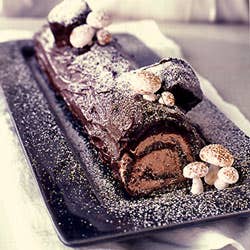
If all the delights that grace the French Christmas table, probably nothing inspires more pure, childlike joy than the buche de Noel, or Yule log: a delectable vision composed of a length of jelly-roll sponge spread with lip-smacking buttercream (traditionally chocolate- or chestnut-flavored), rolled, and covered with a glossy chocolate bark made of more buttercream or ganache—the whole then garnished with cocoa-dusted meringue mushrooms, so cleverly sculpted they might almost be real, and sometimes with almond-paste holly leaves as well.
Real Yule logs—the kind that come from trees—have had symbolic significance to the French for centuries. Until the late 1800s it was a widespread custom on Christmas Eve for extended families, especially poorer ones, to gather under one roof, with each member bringing a log of wood to fuel the fire. In the glow of the embers, the family might sing carols—then troop off to midnight mass.
The earliest mention of something resembling an edible Yule log appears in Le Memorial historique et geographique de la patisserie (1890) by Pierre Lacam, one of the great French pastry chefs and culinary historians of the 19th century. Lacam describes a log-shaped cake made from a genoise sponge and buttercream, but he does not give a source for its creation. One theory is that the idea may have developed originally as a variation on the cylindrical, multilayered Baumkuchen—literally, "tree cake"—of Austria, which is made by pouring layer after layer of thick batter over a rotating spit in the fireplace. The result looks a lot like a tree trunk, and it seems possible that some French pastry chef, perhaps in Alsace, refined and embellished the dessert.
Whatever its origins, the sponge-cake buche de Noel didn't become really popular in France until the early decades of the 20th century, as Christmas evolved from a predominantly religious occasion into an increasingly secular holiday—one for which yuletide feasts with elaborate confectionary centerpieces perhaps took on as much importance as midnight masses.
By the time Auguste Escoffier published his Special Reveillon (Christmas-Eve Special) in 1928—in which he specified buche de Noel as part of his recommended family Christmas menu (along with "exquisite cigars" and Veuve Cliquot), it was obviously well on its way to being the beloved classic that it has become today.
Keep Reading
Continue to Next Story










